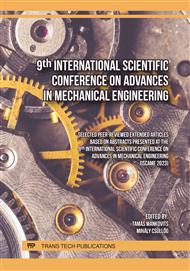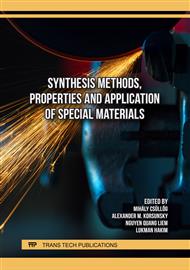[1]
Gregor Dolanc, Vladimir Jovan- Improvement of the drying process control is a clay product plant IFAC Proceedings Volume 30, Issue 6, May 1997, Pages 1575-1580
DOI: 10.1016/s1474-6670(17)43585-3
Google Scholar
[2]
D.D. Furszyfer Del Rio et al., Renewable and Sustainable Energy Reviews 157 (2022) 112081
Google Scholar
[3]
https://cerameunie.eu
Google Scholar
[4]
K. Junge, E. Rimpel, F. Rehme - Verbesserung der Formgebungseigenschaften und der Produktqualität durch Zusätze zum Rohstoff unter besonderer Berücksichtigung des elektrischen Energieverbrauchs der Presse (2004)
Google Scholar
[5]
Krause, E., I. Berger, J. Nehlert J. Wiegmann Technologie der Keramik, Band 1: Verfahren-Rohstoffe-Erzeugnisse, 2. Auflage VEB Verlag für Bauwesen, Berlin (1981) und (1985)
Google Scholar
[6]
I. Kocserha, L. A. Gömze Friction properties of clay compounds Applied Clay Science Volume 48, Issue 3, April 2010, Pages 425-430
DOI: 10.1016/j.clay.2010.01.017
Google Scholar
[7]
Jürgen G. Heinrich, Cynthia M. Gomes - Einführung in die Technologie der Keramik
Google Scholar
[8]
H. Schubert: Aufbereitung fester mineralischer Rohstoffe, Band I-III, VEB Dt. Verlag für Grundstoffindustrie, Leipzig 1972, 1975, 1978.
DOI: 10.1002/maco.19720231224
Google Scholar
[9]
Stuart Blackburn, D. Ian Wilson Shaping ceramics by plastic processing 2008 Journal of the European Ceramic Society 28, Issue 7, pp.1341-1351
DOI: 10.1016/j.jeurceramsoc.2007.12.013
Google Scholar
[10]
W.C. Browling the hydroxyl factor in shale control 1964 J Pet Technol 16 (10): 1177–1186
Google Scholar
[11]
Stephen B. Johnson , David R. Dixon , Peter J. Scales The electrokinetic and shear yield stress properties of kaolinite in the presence of aluminium ions Colloids and Surfaces A: Physicochemical and Engineering Aspects 146 (1999) 281–291
DOI: 10.1016/s0927-7757(98)00726-2
Google Scholar
[12]
O Kotova, Clay Minerals 2013 IOP Conference Series: Materials Science and Engineering 47 012037
Google Scholar
[13]
BEIS, British Ceramic Confederation Joint industry - government industrial decarbonization and energy efficiency Roadmap action plan. London (2017)
Google Scholar
[14]
DECCIndustrial decarbonization & energy efficiency roadmaps to 2050 ceramic sector. London (2015)
Google Scholar
[15]
Dyan D. Furszyfer Del Rio et al Decarbonizing the ceramics industry: A systematic and critical review of policy options, developments and sociotechnical systems 2022 Renewable and Sustainable Energy Reviews 157, 112081
DOI: 10.1016/j.rser.2022.112081
Google Scholar
[16]
Hans van Wijck, Hans Marks Consequences of using additives for reducing the amount of mixing water needed in the heavy clay ceramic industry (2007)
Google Scholar
[17]
Winkel Alexander Energiesparende Verfahren für die Ziegelformgebung 2014 Ziegelindustrie International 67
Google Scholar
[18]
Carlos Maurício Fontes Vieira, Sergio Neves Monteiro Reformulation of a kaolinitic clay ceramic body with sand flux clay for roofing tiles production 2012 Materials Science Forum 727-728 pp.965-970
DOI: 10.4028/www.scientific.net/msf.727-728.965
Google Scholar
[19]
M. Romagnoli, F. Andreola Mixture of deflocculants: A systematic approach Journal of the European Ceramic Society Volume 27, Issues 2–3, 2007, Pages 1871-1874
DOI: 10.1016/j.jeurceramsoc.2006.05.065
Google Scholar
[20]
L A Gömze, S N Kulkov, E Kurovics, A S Buyakov, S P Buyakova, A Y Buzimov, R Géber, MV Grigoriev, I Kocserha, A S Kulkov, T Yu. Sablina, N L Savchenko, I N Sevostyanova, A. Simon 2018 Építőanyag-JSBCM 70 (1) 8
DOI: 10.14382/epitoanyag-jsbcm.2018.2
Google Scholar
[21]
L A Gömze, S N Kulkov, E Kurovics, A S Buyakov, A Y Buzimov, M V Grigoriev, B I Kanev,T V Kolmakova, R V Levkova, R V Levkov, S A Sitkevich 2018 Építőanyag-JSBCM 70 (1) 13
DOI: 10.14382/epitoanyag-jsbcm.2018.3
Google Scholar
[22]
F.A. Andrade, H.A. Al-Qureshi , D. Hotza - Measuring the plasticity of clays: A review
Google Scholar
[23]
M. Jakab, G. B. Patthy, T. Korim, É. Makó Investigation of the Usability of Reduced Alkalinity Red Mud in the Building Material Industry Resources 2023, 12(7), 79
DOI: 10.3390/resources12070079
Google Scholar



